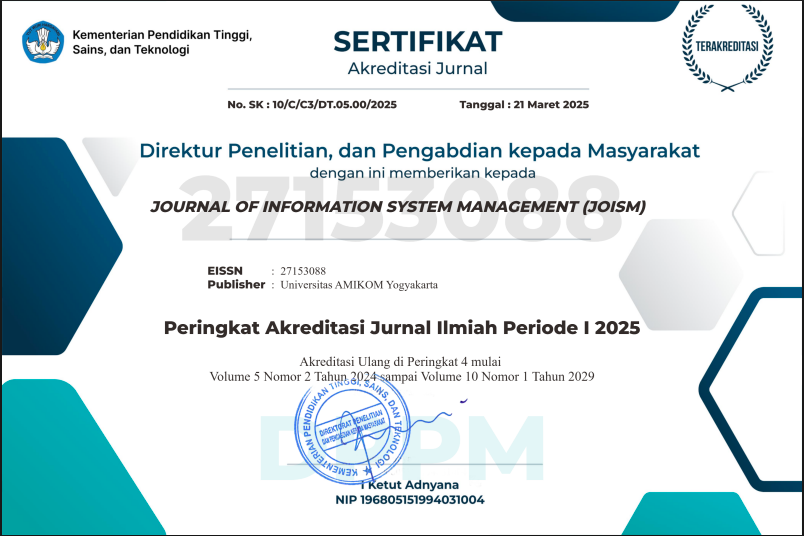IMPLEMENTASI VIRTUAL REALITY DALAM PEMASARAN PARIWISATA
(STUDI PADA TAMAN PINTAR DAN PLAY BOTH)
DOI:
https://doi.org/10.24076/joism.2023v5i1.1084Keywords:
Pariwisata, Pemasaran, Perilaku Wisatawan, Virtual RealityAbstract
Perkembangan teknologi memberikan peluang dalam aktivitas pemasaran pariwisata. Penggunaan virtual reality (VR) menjadi salah satu upaya yang dapat dilakukan. Virtual reality dianggap sebagai cara yang mampu membatasi aktivitas kunjungan. Penelitian ini bertujuan untuk mengungkap perubahan aktivitas nyata menjadi aktivitas virtual berdasarkan pengalaman yang dirasakan. Desain penelitian kualitatif melalui pendekatan studi kasus digunakan pada pengguna layanan VR di museum Taman Pintar dan Play Both Mall Pakuwon. Penelitian ini mampu mengungkap pengalaman seseorang setelah menggunakan layanan VR. Analisa Miles Huberman dikombinasikan dengan metode semi-immersive dan model UTAUT digunakan dalam penelitian ini. Hasil penelitian menemukan jika kesenangan menjadi salah satu faktor pendorong penerimaan teknologi VR. Sedangkan kondisi teknologi, aktivitas sosial dan interaksi yang dilakukan menjadi salah satu penghambat. Meskipun demikian, penggunaan layanan VR mampu menjadi salah satu cara merangsang motivasi pengguna.
References
S. Adi and S. Heripracoyo, “Potential benefits and logical design of web collaboration to support tourism promotion and marketing at provincial level in Indonesia,” Int. J. Mech. Eng. Technol., vol. 9, no. 11, pp. 177–191, 2018.
G. Aydin, “Social media engagement and organic post effectiveness: A roadmap for increasing the effectiveness of social media use in hospitality industry,” J. Hosp. Mark. Manag., vol. 29, no. 1, pp. 1–21, 2020, doi: 10.1080/19368623.2019.1588824.
S. S. Dadwal and A. Hassan, “The augmented reality marketing: A merger of marketing and technology in tourism,” in Mobile Computing and Wireless Networks: Concepts, Methodologies, Tools, and Applications, Glyndwr University, London Campus, United Kingdom: IGI Global, 2015, pp. 63–80. doi: 10.4018/978-1-4666-8751-6.ch004.
A. A., L. D., G. E.A., and G. O. J.C., Eds., “International Conference on Tourism, Technology and Systems, ICOTTS 2020,” Int. Conf. Tour. Technol. Syst. ICOTTS 2020, vol. 209, 2021, [Online]. Available: https://www.scopus.com/inward/record.uri?eid=2-s2.0-85097175755&partnerID=40&md5=028579593448d2edd454686481908751
S. Gössling, “Tourism, technology and ICT: a critical review of affordances and concessions,” J. Sustain. Tour., vol. 29, no. 5, pp. 733–750, 2021, doi: 10.1080/09669582.2021.1873353.
R. Cheong, “The virtual threat to travel and tourism,” Tour. Manag., vol. 16, no. 6, pp. 417–422, 1995, doi: 10.1016/0261-5177(95)00049-T.
M. Rauscher, A. Humpe, and L. Brehm, “Virtual reality in tourism: Is it ‘Real’ enough?,” Acad. Tur., vol. 13, no. 2, pp. 127–138, 2020, doi: 10.26493/2335-4194.13.127-138.
L. P. Voronkova, “Virtual Tourism: On the Way to the Digital Economy,” presented at the International Multi-Conference on Industrial Engineering and Modern Technologies 2018, Lomonosov Moscow State University, Moscow, Russian Federation: Institute of Physics Publishing, 2018. doi: 10.1088/1757-899X/463/4/042096.
P. Disztinger, S. Schlögl, and A. Groth, “Technology Acceptance of Virtual Reality for Travel Planning,” Springer, vol. 2017, no. Information and Communication Technologies in Tourism, pp. 255–268, doi: 10.1007/978-3-319-51168-9_19.
E. E. Bennett and R. R. McWhorter, “Virtual HRD’s Role in Crisis and the Post Covid-19 Professional Lifeworld: Accelerating Skills for Digital Transformation,” Adv. Dev. Hum. Resour., vol. 23, no. 1, pp. 5–25, Jan. 2021, doi: 10.1177/1523422320973288.
S. M. C. Loureiro, R. G. Bilro, and F. J. de A. Angelino, “Virtual reality and gamification in marketing higher education: a review and research agenda,” Span. J. Mark. - ESIC, vol. 25, no. 2, pp. 179–216, Jan. 2021, doi: 10.1108/SJME-01-2020-0013.
O. El-Said and H. Aziz, “Virtual Tours a Means to an End: An Analysis of Virtual Tours’ Role in Tourism Recovery Post COVID-19,” J. Travel Res., p. 0047287521997567, Mar. 2021, doi: 10.1177/0047287521997567.
L. P. Voronkova, “Virtual Tourism: On the Way to the Digital Economy,” in IOP Conf. Ser. Mater. Sci. Eng., Institute of Physics Publishing, 2018. doi: 10.1088/1757-899X/463/4/042096.
C. B. Sox, S. F. Kline, T. B. Crews, S. K. Strick, and J. M. Campbell, “Virtual and Hybrid Meetings: A Mixed Research Synthesis of 2002-2012 Research,” J. Hosp. Tour. Res., vol. 41, no. 8, pp. 945–984, 2017, doi: 10.1177/1096348015584437.
R. Repoviene and A. Pazeraite, “Content marketing decisions for customers’ desired value in the tourism sector,” presented at the 25th Annual International Scientific Conference Research for Rural Development, 2019, Vytautas Magnus University, Lithuania: Jelgava?: Latvia University of Agriculture, 2019, pp. 284–291. doi: 10.22616/rrd.25.2019.081.
A. Hassan and T. Jung, “Augmented reality as an emerging application in tourism marketing education,” in Emerg. Tools and Appl. of Virtual Real. in Educ., IGI Global, 2016, pp. 168–185. [Online]. Available: https://www.scopus.com/inward/record.uri?eid=2-s2.0-84981229135&doi=10.4018%2f978-1-4666-9837-6.ch008&partnerID=40&md5=68ae476d07f25d42c4a20f4ba1d5ed21
B. Raki? and M. Raki?, “Digital Marketing of Tourism Organizations In Function Of Tourism Promotion In Serbia,” TISC - Tour. Int. Sci. Conf. Vrnja?. Banja, vol. 5, no. 1, pp. 399–415, Sep. 2020.
L. Karvele and D. Znoti?a, “Evaluation of digital marketing use in the promotion of Latgale region tourism,” presented at the 12th International Scientific and Practical Conference on Environment. Technology. Resources, Faculty of Economics and Management, Rezekne Academy of Technologies, Rezekne, Latvia: Rezekne Higher Education Institution, 2019, pp. 195–199. doi: 10.17770/etr2019vol2.4055.
K.-Y. Sin, A. A. Mohamad, and M.-C. Lo, “A critical review of literature in the rising tide of social media towards promoting tourism,” Enlightening Tour., vol. 10, no. 2, pp. 270–305, 2020, doi: 10.33776/et.v10i2.4887.
C. Veiga, M. C. Santos, P. Águas, and J. A. C. Santos, “Are millennials transforming global tourism? Challenges for destinations and companies,” Worldw. Hosp. Tour. Themes, vol. 9, no. 6, pp. 603–616, 2017, doi: 10.1108/WHATT-09-2017-0047.
N. Camatti, D. Bertocchi, H. Cari?, and J. van der Borg, “A digital response system to mitigate overtourism. The case of Dubrovnik,” J. Travel Tour. Mark., vol. 37, no. 8–9, pp. 887–901, 2020, doi: 10.1080/10548408.2020.1828230.
E. Happ and Z. Ivancsóné Horváth, “A study of digital marketing tools usage habits among Hungarian tourists,” Geoj. Tour. Geosites, vol. 32, no. 4, pp. 1283–1289, 2020, doi: 10.30892/GTG.32414-570.
F. Higgins-Desbiolles, S. Carnicelli, C. Krolikowski, G. Wijesinghe, and K. Boluk, “Degrowing tourism: rethinking tourism,” J. Sustain. Tour., vol. 27, no. 12, pp. 1926–1944, 2019, doi: 10.1080/09669582.2019.1601732.
R. Aryanto and Mulyani, “Website user interface of marine bio-tourism destination for today digital environment,” Int. J. Innov. Technol. Explor. Eng., vol. 8, no. 12, pp. 2064–2067, 2019, doi: 10.35940/ijitee.L3266.1081219.
C. Hofacker, I. Golgeci, K. G. Pillai, and D. M. Gligor, “Digital marketing and business-to-business relationships: a close look at the interface and a roadmap for the future,” Eur. J. Mark., vol. 54, no. 6, pp. 1161–1179, May 2020, doi: 10.1108/EJM-04-2020-0247.
P. Foroudi, S. Gupta, A. Nazarian, and M. Duda, “Digital technology and marketing management capability: achieving growth in SMEs,” Qual. Mark. Res. Int. J., vol. 20, no. 2, pp. 230–246, Apr. 2017, doi: 10.1108/QMR-01-2017-0014.
B. Alzougool, “The use and continuance use of social media applications by small and medium enterprises in Kuwait,” Glob. Knowl. Mem. Commun., vol. 68, no. 6/7, pp. 471–490, Sep. 2019, doi: 10.1108/GKMC-11-2018-0094.
J. C. Bondra and T. R. V. Davis, “Marketing’s role in cross-functional information management,” Ind. Mark. Manag., vol. 25, no. 3, pp. 187–195, May 1996, doi: 10.1016/0019-8501(95)00076-3.
E. Arrigo, “Social media marketing in luxury brands: A systematic literature review and implications for management research,” Manag. Res. Rev., vol. 41, no. 6, pp. 657–679, Jun. 2018, doi: 10.1108/MRR-04-2017-0134.
H. El-Gohary and R. Eid, “DMA Model: Understanding digital marketing adoption and implementation by Islamic Tourism Organizations,” Tour. Anal., vol. 17, no. 4, pp. 523–532, 2012, doi: 10.3727/108354212X13473157390885.
T. Hennig-Thurau et al., “The Impact of New Media on Customer Relationships,” J. Serv. Res., vol. 13, no. 3, pp. 311–330, Aug. 2010, doi: 10.1177/1094670510375460.
E. M. Rogers, Diffusion of innovations, 3rd ed. New York?: London: Free Press?; Collier Macmillan, 1983.
W. Ritz, M. Wolf, and S. McQuitty, “Digital marketing adoption and success for small businesses: The application of the do-it-yourself and technology acceptance models,” J. Res. Interact. Mark., vol. 13, no. 2, pp. 179–203, Jun. 2019, doi: 10.1108/JRIM-04-2018-0062.
H. Karjaluoto, N. Mustonen, and P. Ulkuniemi, “The role of digital channels in industrial marketing communications,” J. Bus. Ind. Mark., vol. 30, no. 6, pp. 703–710, Jul. 2015, doi: 10.1108/JBIM-04-2013-0092.
K. Wertime and I. Fenwick, DigiMarketing, he Essential Guide to New Media and Digital Marketing. 2008, p. 3.
Y. Na and J. Kim, “Sensibility and response keywords of users according to posting types of fashion Instagram: Focused on Koreans’ fashion brands,” Int. J. Cloth. Sci. Technol., vol. 32, no. 1, pp. 23–36, May 2019, doi: 10.1108/IJCST-03-2018-0032.
R. Cheong, “The virtual threat to travel and tourism,” Tour. Manag., vol. 16, no. 6, pp. 417–422, 1995, doi: 10.1016/0261-5177(95)00049-T.
P. Long and N. D. Morpeth, “Critiquing creativity in tourism,” in The Routledge Handb. of Cultural Tourism, Taylor and Francis, 2013, pp. 304–310. [Online]. Available: https://www.scopus.com/inward/record.uri?eid=2-s2.0-85063454063&doi=10.4324%2F9780203120958&partnerID=40&md5=dc427ecba9af03ccea7c12ba9c4dff4f
V. Mathew and M. Soliman, “Does digital content marketing affect tourism consumer behavior? An extension of technology acceptance model,” J. Consum. Behav., vol. 20, no. 1, pp. 61–75, 2021, doi: 10.1002/cb.1854.
M. E. Styvén and Å. Wallström, “Benefits and barriers for the use of digital channels among small tourism companies,” Scand. J. Hosp. Tour., vol. 19, no. 1, pp. 27–46, 2019, doi: 10.1080/15022250.2017.1379434.
Y. Wu, S. Nambisan, J. Xiao, and K. Xie, “Consumer resource integration and service innovation in social commerce: the role of social media influencers,” J. Acad. Mark. Sci., vol. 50, no. 3, pp. 429–459, 2022, doi: 10.1007/s11747-022-00837-y.
M. Fishbein and I. Ajzen, Predicting And Chaning Behavior?; The reasoned Action Approach. New York: Psychology Press, 1975.
M. Fishbein and I. Ajzen, Belief, Attitude, Intention, And Behavior?; An introduction to theory and research, vol. 5. 1990.
F. D. Davis, R. P. Bagozzi, and P. R. Warshaw, “User Acceptance of Computer Technology: A Comparison of Two Theoretical Models,” Manag. Sci., vol. 35, no. 8, pp. 982–1003, 1989, doi: 10.1287/mnsc.35.8.982.
C. Hofacker, I. Golgeci, K. G. Pillai, and D. M. Gligor, “Digital marketing and business-to-business relationships: a close look at the interface and a roadmap for the future,” Eur. J. Mark., vol. 54, no. 6, pp. 1161–1179, May 2020, doi: 10.1108/EJM-04-2020-0247.
P. Foroudi, S. Gupta, A. Nazarian, and M. Duda, “Digital technology and marketing management capability: achieving growth in SMEs,” Qual. Mark. Res., vol. 20, no. 2, pp. 230–246, 2017, doi: 10.1108/QMR-01-2017-0014.
B. Alzougool, “The use and continuance use of social media applications by small and medium enterprises in Kuwait,” Glob. Knowl. Mem. Commun., vol. 68, no. 6/7, pp. 471–490, Sep. 2019, doi: 10.1108/GKMC-11-2018-0094.
J. Creswell and David, “Research Design Qualitative, Quantitative and Mix Methods Approaches,” pp. 388–388, 2019.
T. E. Yudiandri and A. Sulistyo, “Excellent And Sustainable Tourism Management Through The Baldrige Criteria: Case Study: Mangunan Orchard Tourism Attraction,” J. Res. Bus. Tour., vol. Volume 2 No. 2, pp. 78–94, Dec. 2022, doi: https://doi.org/10.37535/104002220221.
A. Sulistyo, “Penerapan Tourism Marketing 3.0 Pada Desa Wisata Tinalah Dalam Upaya Meningkatkan Kualitas Produk Wisata,” J. Tour. Destin. Attract., vol. 9, no. 3, pp. 1–8, 2021.
A. Sulistyo, I. Fatmawati, and N. Nuryakin, “Creating Sustainable Tourism Through Innovation (Digital-Based Marketing In The Tinalah Rural Tourism),” Proc. Int. Acad. Conf. Tour. INTACT, vol. Proceedings of the International Academic Conference on Tourism (INTACT) "Post Pandemic Tourism: Trends and Future Directions" (INTACT 2022), no. Advances in Social Science, Education and Humanities Research, pp. 400–416, Dec. 2022, doi: https://doi.org/10.2991/978-2-494069-73-2_29.
V. Venkatesh, M. G. Morris, G. B. Davis, and F. D. Davis, “User Acceptance of Information Technology: Toward a Unified View,” Manag. Inf. Syst. Res. Cent., vol. 27, no. 3, pp. 425–478, Sep. 2003, doi: 10.2307/30036540.
M. B. Miles and M. A. Huberman, qualitative _Data Analysis.pdf, Second Edi. London: SAGE Publications Inc., 1994.
A. Hussain, M. F. Abid, A. Shamim, D. H. Ting, and M. A. Toha, “Videogames-as-a-service: How does in-game value co-creation enhance premium gaming co-creation experience for players?,” J. Retail. Consum. Serv., vol. 70, 2023, doi: 10.1016/j.jretconser.2022.103128.
Downloads
Published
Issue
Section
License
Copyright (c) 2023 Journal of Information System Management (JOISM)

This work is licensed under a Creative Commons Attribution 4.0 International License.













